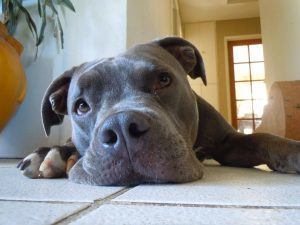
Preventing Heat Stroke in your Dog
Preventing Heat Stroke in your Dog
Heat stroke is a life threatening condition that is particularly dangerous for dogs. It is always an emergency. And with this Summer looking especially hot, it’s vitally important to understand how to keep your pup safe in the heat. Fortunately, it’s simple! In this article, you’ll learn the basics of how your dog keeps cool. You’ll learn how heat-stroke affects dogs, signs and symptoms, how to treat it, along with the most commonly dangerous situations. Finally, we’ll teach you easy tips on how to help keep your companion comfortable in the heat!
How a dog keeps cool
Dogs can’t perspire in order to cool themselves like humans do. Dogs mainly rely on panting in order to cool themselves, which allows them to exchange warmer body temperatures with the cooler air outside. However, when the surrounding air is not significantly cooler than their body temperature, their cooling process can’t work. Panting also becomes much less effective when there are high levels of humidity – such as in a parked car. This often leads to a dangerous rise in body temperature, and can trigger heat-stroke.
Heat stroke – the basics
Remember, dogs have much less efficient temperature regulating mechanisms than we do. Heat stroke occurs when these mechanisms are overpowered by the environment. Certain breeds (especially small snouted breeds, like pugs), older dogs, along with pets with medical conditions, are more susceptible. Moderate heat stroke (body temperature of 104-106 degrees) can be treated with prompt veterinary care and first aid. Severe heat stroke (above 106 degrees) is life threatening, and can cause permanent damage to your pet’s vital organs.
Signs and symptoms
- Rapid panting
- Bright red tongue
- Sticky saliva
- Red or pale gums
- Dizziness or weakness
- Vomiting (sometimes with blood)
- Diarrhea
- Coma
What to do
If your dog is showing any signs of heat stroke, you need to call us immediately – it’s an emergency situation. If immediate veterinary care is unavailable to you for some reason, take the following steps: Immediately remove your dog from the hot area. Lower your dog’s temperature by wetting them with cool water. If it’s a smaller dog, the water should be lukewarm. Increase air movement around them with a fan. Make sure not to use cold water – if you lower your dog’s body temperature too quickly, it can trigger other life-threatening situations. Take your dog’s rectal temperature every 5 minutes. Once they are down to 103 degrees, dry them off, and cover with clean towels so they don’t continue to lose heat. Your dog may be dehydrated, or have other complications, so bring them to us (or a nearby veterinarian) ASAP.
Preventing commonly dangerous situations
- Even if the windows are rolled down, the car is an extremely dangerous place to leave your pet. Just don’t ever do it. The car essentially acts as an oven, causing temperatures to rise quicker than most realize. Temperatures in a parked car can quickly rise to upwards of 120 degrees.
- If your pet has breathing problems, obesity, heart disease, or old-age, you need to be sure to keep them with access to a cool, shaded spot with water at all times.
- Limit exercise on especially hot days – jogging is especially dangerous. Don’t go on hikes with your dog in the heat. Often times pets will try to keep up, and then just collapse from heat stroke.
- Avoid surfaces like sand/asphalt or concrete – prolonged exposure can quickly cause increases in body temperature.
- Never muzzle your dog in the heat – you’re taking away their best way of temperature regulation.
- Always provide access to water.
- If your dog is outdoors during the day, always provide a shaded area with plenty of water.
Three ways to keep your dog comfortable
- Conduction – One way that pets keep cool is by transferring body heat to a cooler surface, especially through the belly. This is why it’s important to provide them with cool surfaces to lay on, such as tiled areas, or a hole in the shade.
- Convection – Your dog relies on air movement to speed the loss of heat. This is why dogs love to stick their heads out of the car when you drive. Set up cross breezes for your dog – whether through fans and open doors, or air conditioning.
- Evaporation – Humans can perspire in order to be cooled by evaporation, but dogs need a little help. Consider periodically wetting your dog down with a cool, damp towel, or allowing them to go for a (supervised!) swim.




